MGT5OBR: Individual Assignment on Motivation and Engagement Theories
VerifiedAdded on 2022/12/23
|12
|2990
|74
Essay
AI Summary
This essay delves into the realm of organisational behaviour, focusing on two prominent theories of motivation and engagement: Goal Setting Theory and Herzberg's Two-Factor Theory. The essay begins by introducing both theories, highlighting their significance in the context of organisational behaviour and their relevance to achieving high performance and job satisfaction. The analysis then critically examines the Goal Setting Theory, exploring its core principles, including the importance of specific and challenging goals, the role of feedback, and the impact of goal commitment and self-efficacy. The essay also provides the pros and cons of the Goal Setting Theory. Next, the essay scrutinizes Herzberg's Two-Factor Theory, differentiating between hygiene factors and motivators, and how they influence job satisfaction and dissatisfaction. The essay discusses the pros and cons of Herzberg's theory. A comparison is also made between the two theories, highlighting their interconnectedness in promoting motivation and engagement within an organizational setting. The essay concludes by summarizing the key findings and emphasizing the practical implications of these theories for improving workplace dynamics and employee performance.
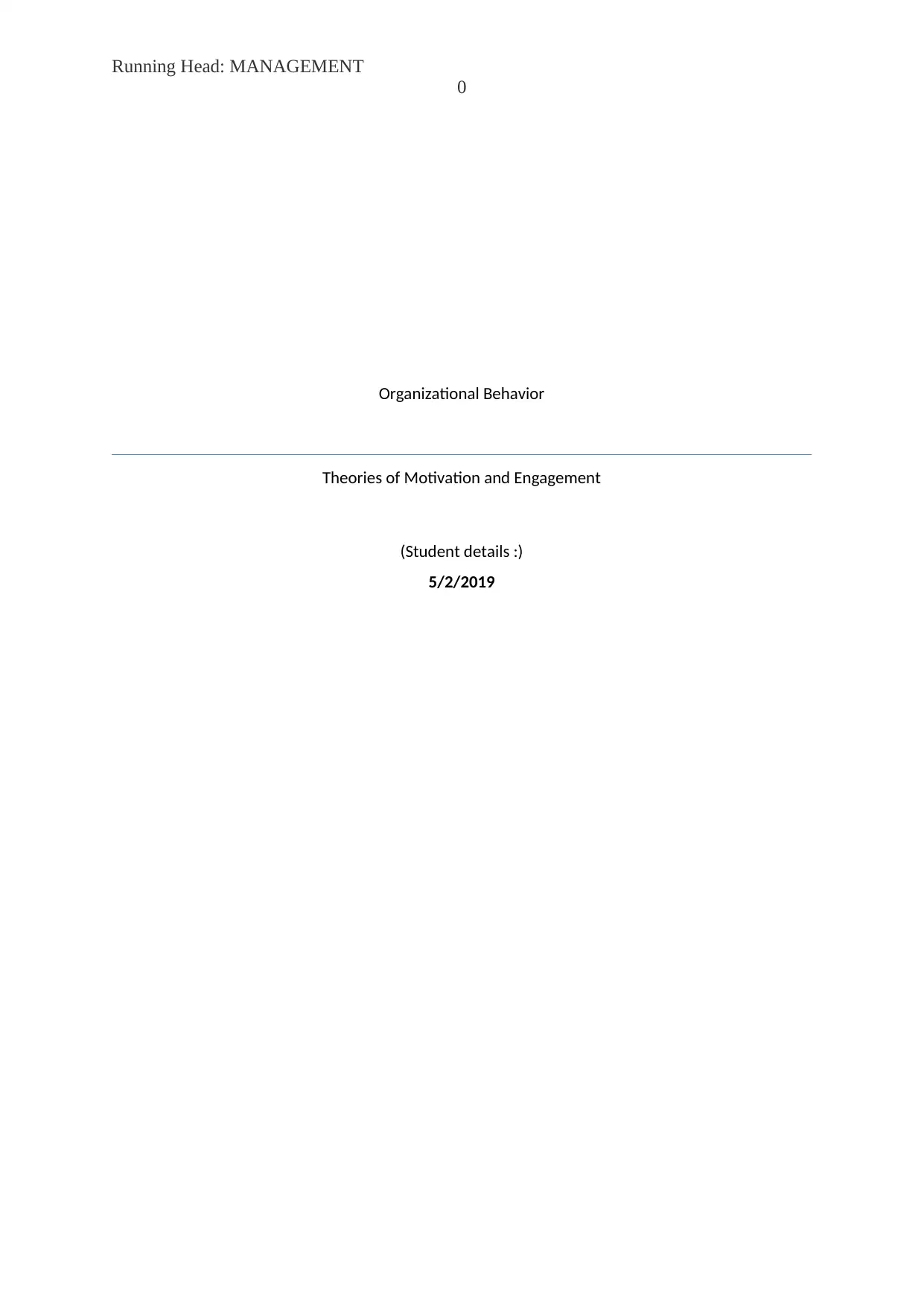
Running Head: MANAGEMENT
0
Organizational Behavior
Theories of Motivation and Engagement
(Student details :)
5/2/2019
0
Organizational Behavior
Theories of Motivation and Engagement
(Student details :)
5/2/2019
Paraphrase This Document
Need a fresh take? Get an instant paraphrase of this document with our AI Paraphraser
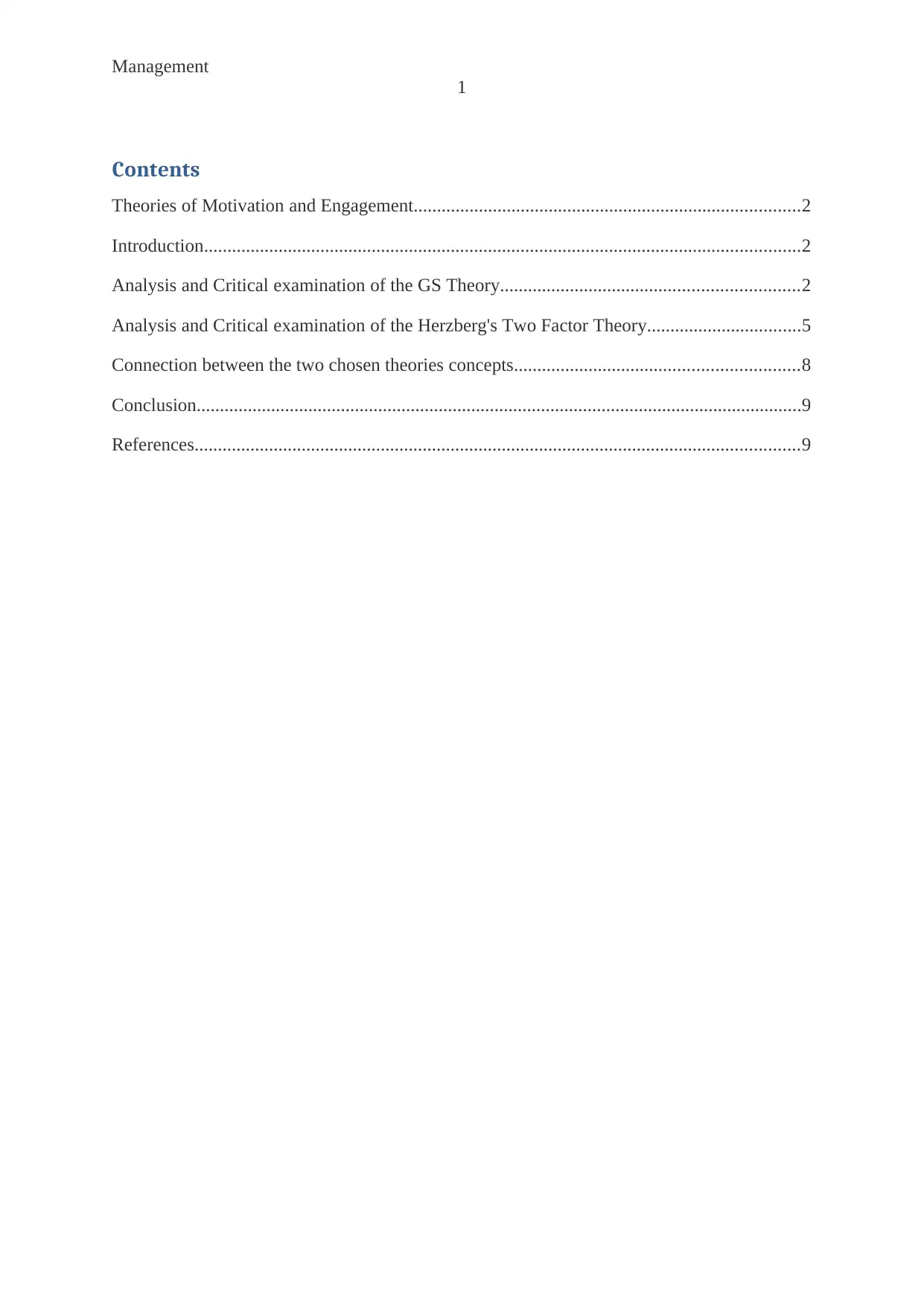
Management
1
Contents
Theories of Motivation and Engagement...................................................................................2
Introduction................................................................................................................................2
Analysis and Critical examination of the GS Theory................................................................2
Analysis and Critical examination of the Herzberg's Two Factor Theory.................................5
Connection between the two chosen theories concepts.............................................................8
Conclusion..................................................................................................................................9
References..................................................................................................................................9
1
Contents
Theories of Motivation and Engagement...................................................................................2
Introduction................................................................................................................................2
Analysis and Critical examination of the GS Theory................................................................2
Analysis and Critical examination of the Herzberg's Two Factor Theory.................................5
Connection between the two chosen theories concepts.............................................................8
Conclusion..................................................................................................................................9
References..................................................................................................................................9
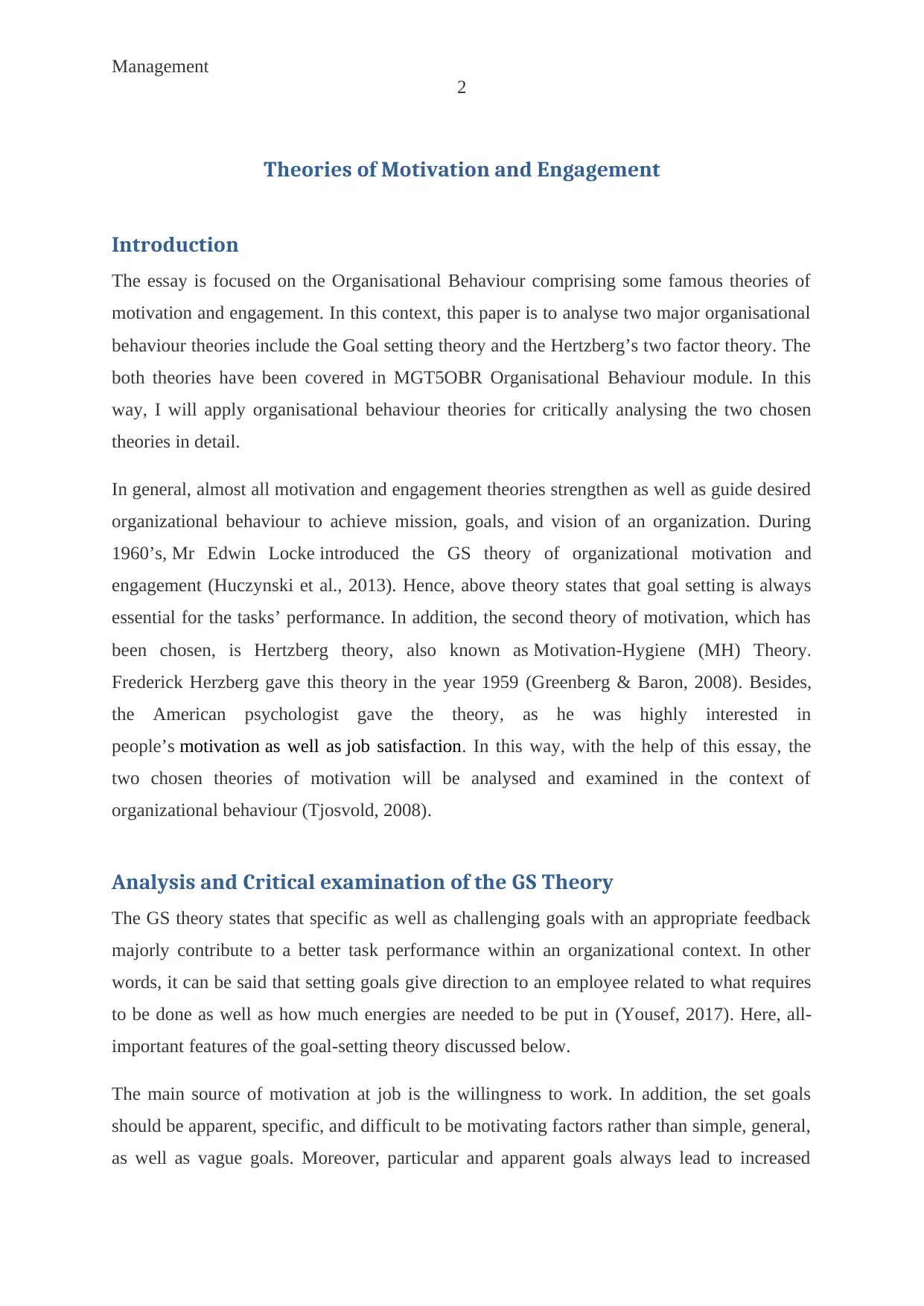
Management
2
Theories of Motivation and Engagement
Introduction
The essay is focused on the Organisational Behaviour comprising some famous theories of
motivation and engagement. In this context, this paper is to analyse two major organisational
behaviour theories include the Goal setting theory and the Hertzberg’s two factor theory. The
both theories have been covered in MGT5OBR Organisational Behaviour module. In this
way, I will apply organisational behaviour theories for critically analysing the two chosen
theories in detail.
In general, almost all motivation and engagement theories strengthen as well as guide desired
organizational behaviour to achieve mission, goals, and vision of an organization. During
1960’s, Mr Edwin Locke introduced the GS theory of organizational motivation and
engagement (Huczynski et al., 2013). Hence, above theory states that goal setting is always
essential for the tasks’ performance. In addition, the second theory of motivation, which has
been chosen, is Hertzberg theory, also known as Motivation-Hygiene (MH) Theory.
Frederick Herzberg gave this theory in the year 1959 (Greenberg & Baron, 2008). Besides,
the American psychologist gave the theory, as he was highly interested in
people’s motivation as well as job satisfaction. In this way, with the help of this essay, the
two chosen theories of motivation will be analysed and examined in the context of
organizational behaviour (Tjosvold, 2008).
Analysis and Critical examination of the GS Theory
The GS theory states that specific as well as challenging goals with an appropriate feedback
majorly contribute to a better task performance within an organizational context. In other
words, it can be said that setting goals give direction to an employee related to what requires
to be done as well as how much energies are needed to be put in (Yousef, 2017). Here, all-
important features of the goal-setting theory discussed below.
The main source of motivation at job is the willingness to work. In addition, the set goals
should be apparent, specific, and difficult to be motivating factors rather than simple, general,
as well as vague goals. Moreover, particular and apparent goals always lead to increased
2
Theories of Motivation and Engagement
Introduction
The essay is focused on the Organisational Behaviour comprising some famous theories of
motivation and engagement. In this context, this paper is to analyse two major organisational
behaviour theories include the Goal setting theory and the Hertzberg’s two factor theory. The
both theories have been covered in MGT5OBR Organisational Behaviour module. In this
way, I will apply organisational behaviour theories for critically analysing the two chosen
theories in detail.
In general, almost all motivation and engagement theories strengthen as well as guide desired
organizational behaviour to achieve mission, goals, and vision of an organization. During
1960’s, Mr Edwin Locke introduced the GS theory of organizational motivation and
engagement (Huczynski et al., 2013). Hence, above theory states that goal setting is always
essential for the tasks’ performance. In addition, the second theory of motivation, which has
been chosen, is Hertzberg theory, also known as Motivation-Hygiene (MH) Theory.
Frederick Herzberg gave this theory in the year 1959 (Greenberg & Baron, 2008). Besides,
the American psychologist gave the theory, as he was highly interested in
people’s motivation as well as job satisfaction. In this way, with the help of this essay, the
two chosen theories of motivation will be analysed and examined in the context of
organizational behaviour (Tjosvold, 2008).
Analysis and Critical examination of the GS Theory
The GS theory states that specific as well as challenging goals with an appropriate feedback
majorly contribute to a better task performance within an organizational context. In other
words, it can be said that setting goals give direction to an employee related to what requires
to be done as well as how much energies are needed to be put in (Yousef, 2017). Here, all-
important features of the goal-setting theory discussed below.
The main source of motivation at job is the willingness to work. In addition, the set goals
should be apparent, specific, and difficult to be motivating factors rather than simple, general,
as well as vague goals. Moreover, particular and apparent goals always lead to increased
⊘ This is a preview!⊘
Do you want full access?
Subscribe today to unlock all pages.

Trusted by 1+ million students worldwide
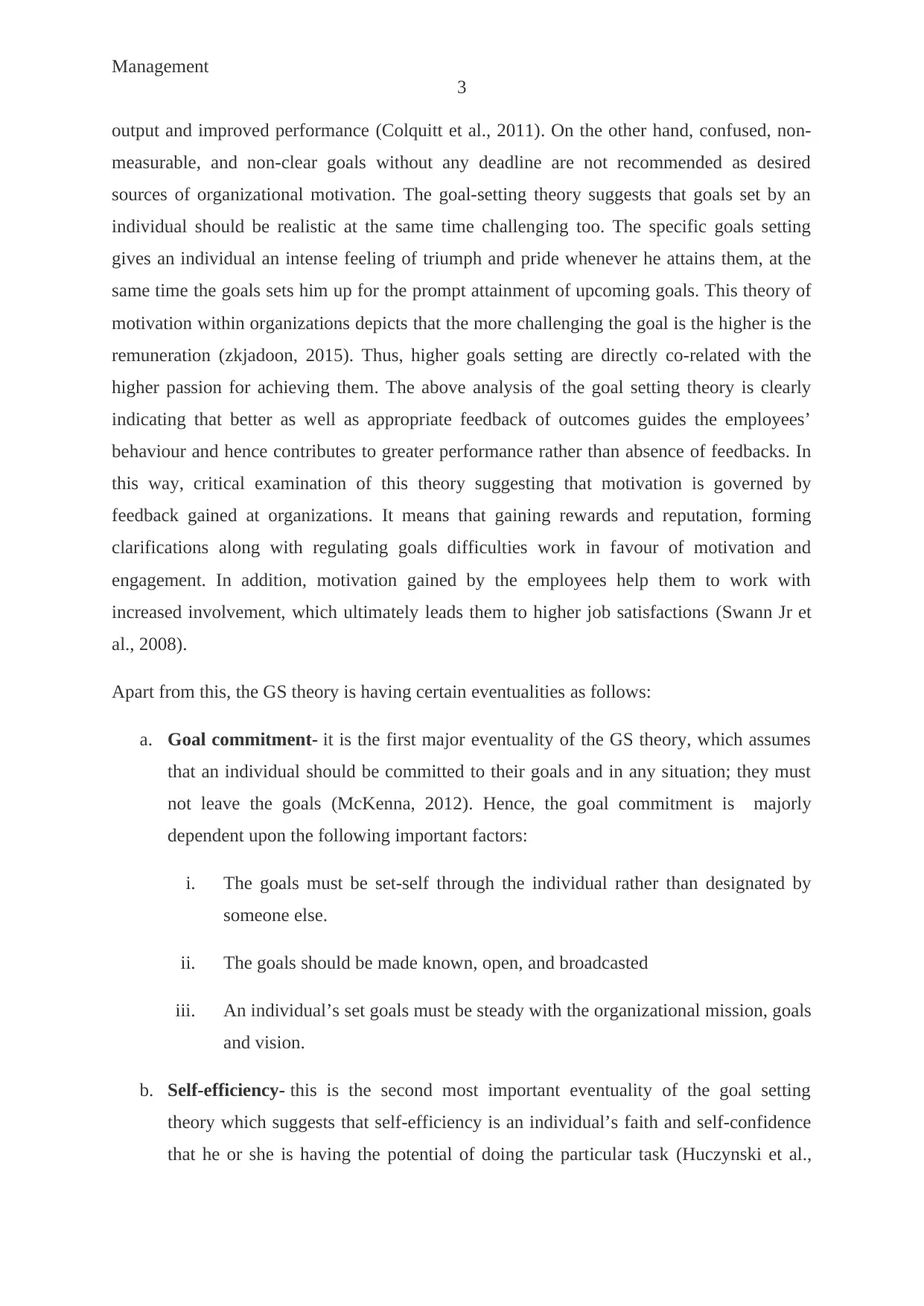
Management
3
output and improved performance (Colquitt et al., 2011). On the other hand, confused, non-
measurable, and non-clear goals without any deadline are not recommended as desired
sources of organizational motivation. The goal-setting theory suggests that goals set by an
individual should be realistic at the same time challenging too. The specific goals setting
gives an individual an intense feeling of triumph and pride whenever he attains them, at the
same time the goals sets him up for the prompt attainment of upcoming goals. This theory of
motivation within organizations depicts that the more challenging the goal is the higher is the
remuneration (zkjadoon, 2015). Thus, higher goals setting are directly co-related with the
higher passion for achieving them. The above analysis of the goal setting theory is clearly
indicating that better as well as appropriate feedback of outcomes guides the employees’
behaviour and hence contributes to greater performance rather than absence of feedbacks. In
this way, critical examination of this theory suggesting that motivation is governed by
feedback gained at organizations. It means that gaining rewards and reputation, forming
clarifications along with regulating goals difficulties work in favour of motivation and
engagement. In addition, motivation gained by the employees help them to work with
increased involvement, which ultimately leads them to higher job satisfactions (Swann Jr et
al., 2008).
Apart from this, the GS theory is having certain eventualities as follows:
a. Goal commitment- it is the first major eventuality of the GS theory, which assumes
that an individual should be committed to their goals and in any situation; they must
not leave the goals (McKenna, 2012). Hence, the goal commitment is majorly
dependent upon the following important factors:
i. The goals must be set-self through the individual rather than designated by
someone else.
ii. The goals should be made known, open, and broadcasted
iii. An individual’s set goals must be steady with the organizational mission, goals
and vision.
b. Self-efficiency- this is the second most important eventuality of the goal setting
theory which suggests that self-efficiency is an individual’s faith and self-confidence
that he or she is having the potential of doing the particular task (Huczynski et al.,
3
output and improved performance (Colquitt et al., 2011). On the other hand, confused, non-
measurable, and non-clear goals without any deadline are not recommended as desired
sources of organizational motivation. The goal-setting theory suggests that goals set by an
individual should be realistic at the same time challenging too. The specific goals setting
gives an individual an intense feeling of triumph and pride whenever he attains them, at the
same time the goals sets him up for the prompt attainment of upcoming goals. This theory of
motivation within organizations depicts that the more challenging the goal is the higher is the
remuneration (zkjadoon, 2015). Thus, higher goals setting are directly co-related with the
higher passion for achieving them. The above analysis of the goal setting theory is clearly
indicating that better as well as appropriate feedback of outcomes guides the employees’
behaviour and hence contributes to greater performance rather than absence of feedbacks. In
this way, critical examination of this theory suggesting that motivation is governed by
feedback gained at organizations. It means that gaining rewards and reputation, forming
clarifications along with regulating goals difficulties work in favour of motivation and
engagement. In addition, motivation gained by the employees help them to work with
increased involvement, which ultimately leads them to higher job satisfactions (Swann Jr et
al., 2008).
Apart from this, the GS theory is having certain eventualities as follows:
a. Goal commitment- it is the first major eventuality of the GS theory, which assumes
that an individual should be committed to their goals and in any situation; they must
not leave the goals (McKenna, 2012). Hence, the goal commitment is majorly
dependent upon the following important factors:
i. The goals must be set-self through the individual rather than designated by
someone else.
ii. The goals should be made known, open, and broadcasted
iii. An individual’s set goals must be steady with the organizational mission, goals
and vision.
b. Self-efficiency- this is the second most important eventuality of the goal setting
theory which suggests that self-efficiency is an individual’s faith and self-confidence
that he or she is having the potential of doing the particular task (Huczynski et al.,
Paraphrase This Document
Need a fresh take? Get an instant paraphrase of this document with our AI Paraphraser
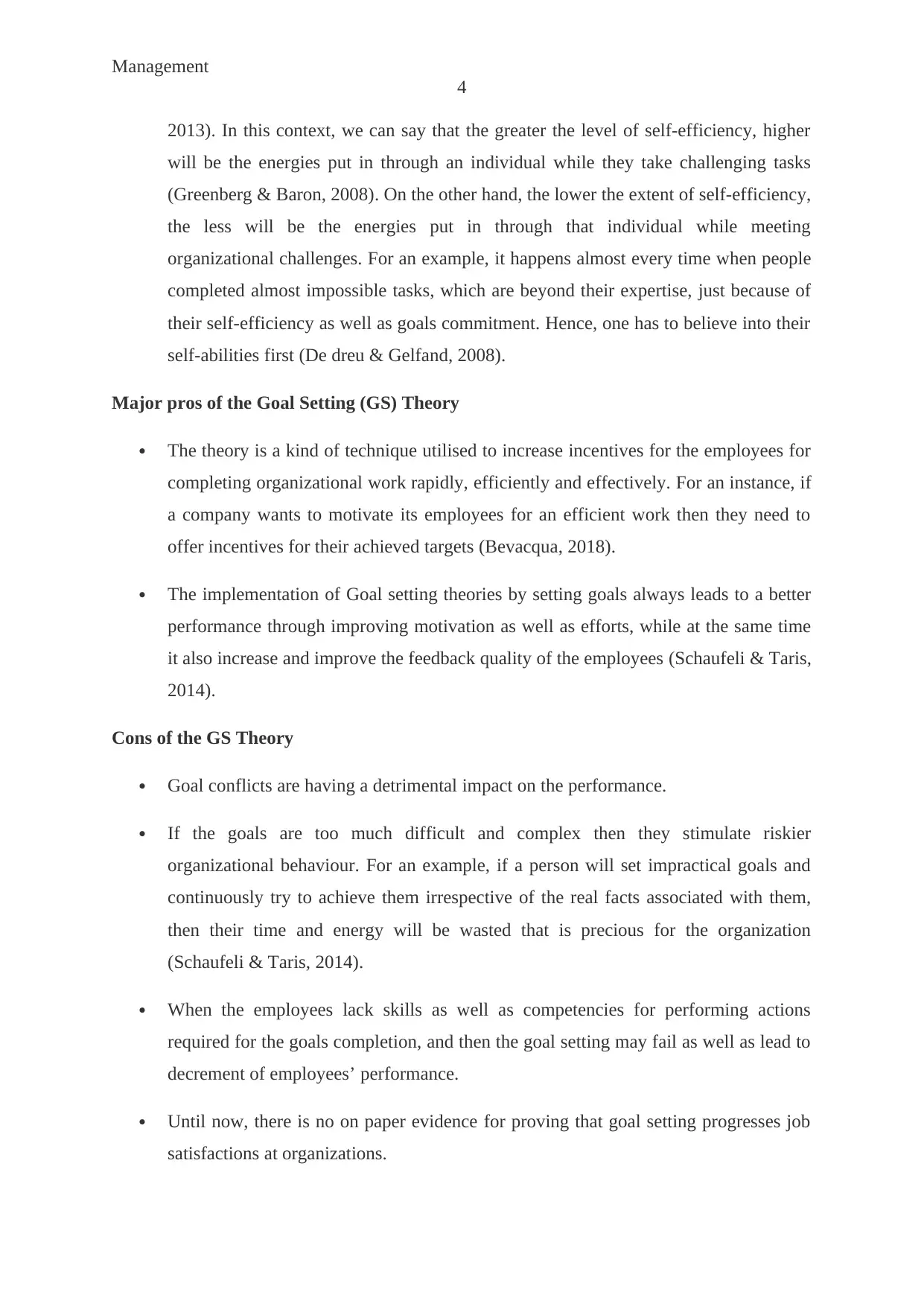
Management
4
2013). In this context, we can say that the greater the level of self-efficiency, higher
will be the energies put in through an individual while they take challenging tasks
(Greenberg & Baron, 2008). On the other hand, the lower the extent of self-efficiency,
the less will be the energies put in through that individual while meeting
organizational challenges. For an example, it happens almost every time when people
completed almost impossible tasks, which are beyond their expertise, just because of
their self-efficiency as well as goals commitment. Hence, one has to believe into their
self-abilities first (De dreu & Gelfand, 2008).
Major pros of the Goal Setting (GS) Theory
The theory is a kind of technique utilised to increase incentives for the employees for
completing organizational work rapidly, efficiently and effectively. For an instance, if
a company wants to motivate its employees for an efficient work then they need to
offer incentives for their achieved targets (Bevacqua, 2018).
The implementation of Goal setting theories by setting goals always leads to a better
performance through improving motivation as well as efforts, while at the same time
it also increase and improve the feedback quality of the employees (Schaufeli & Taris,
2014).
Cons of the GS Theory
Goal conflicts are having a detrimental impact on the performance.
If the goals are too much difficult and complex then they stimulate riskier
organizational behaviour. For an example, if a person will set impractical goals and
continuously try to achieve them irrespective of the real facts associated with them,
then their time and energy will be wasted that is precious for the organization
(Schaufeli & Taris, 2014).
When the employees lack skills as well as competencies for performing actions
required for the goals completion, and then the goal setting may fail as well as lead to
decrement of employees’ performance.
Until now, there is no on paper evidence for proving that goal setting progresses job
satisfactions at organizations.
4
2013). In this context, we can say that the greater the level of self-efficiency, higher
will be the energies put in through an individual while they take challenging tasks
(Greenberg & Baron, 2008). On the other hand, the lower the extent of self-efficiency,
the less will be the energies put in through that individual while meeting
organizational challenges. For an example, it happens almost every time when people
completed almost impossible tasks, which are beyond their expertise, just because of
their self-efficiency as well as goals commitment. Hence, one has to believe into their
self-abilities first (De dreu & Gelfand, 2008).
Major pros of the Goal Setting (GS) Theory
The theory is a kind of technique utilised to increase incentives for the employees for
completing organizational work rapidly, efficiently and effectively. For an instance, if
a company wants to motivate its employees for an efficient work then they need to
offer incentives for their achieved targets (Bevacqua, 2018).
The implementation of Goal setting theories by setting goals always leads to a better
performance through improving motivation as well as efforts, while at the same time
it also increase and improve the feedback quality of the employees (Schaufeli & Taris,
2014).
Cons of the GS Theory
Goal conflicts are having a detrimental impact on the performance.
If the goals are too much difficult and complex then they stimulate riskier
organizational behaviour. For an example, if a person will set impractical goals and
continuously try to achieve them irrespective of the real facts associated with them,
then their time and energy will be wasted that is precious for the organization
(Schaufeli & Taris, 2014).
When the employees lack skills as well as competencies for performing actions
required for the goals completion, and then the goal setting may fail as well as lead to
decrement of employees’ performance.
Until now, there is no on paper evidence for proving that goal setting progresses job
satisfactions at organizations.
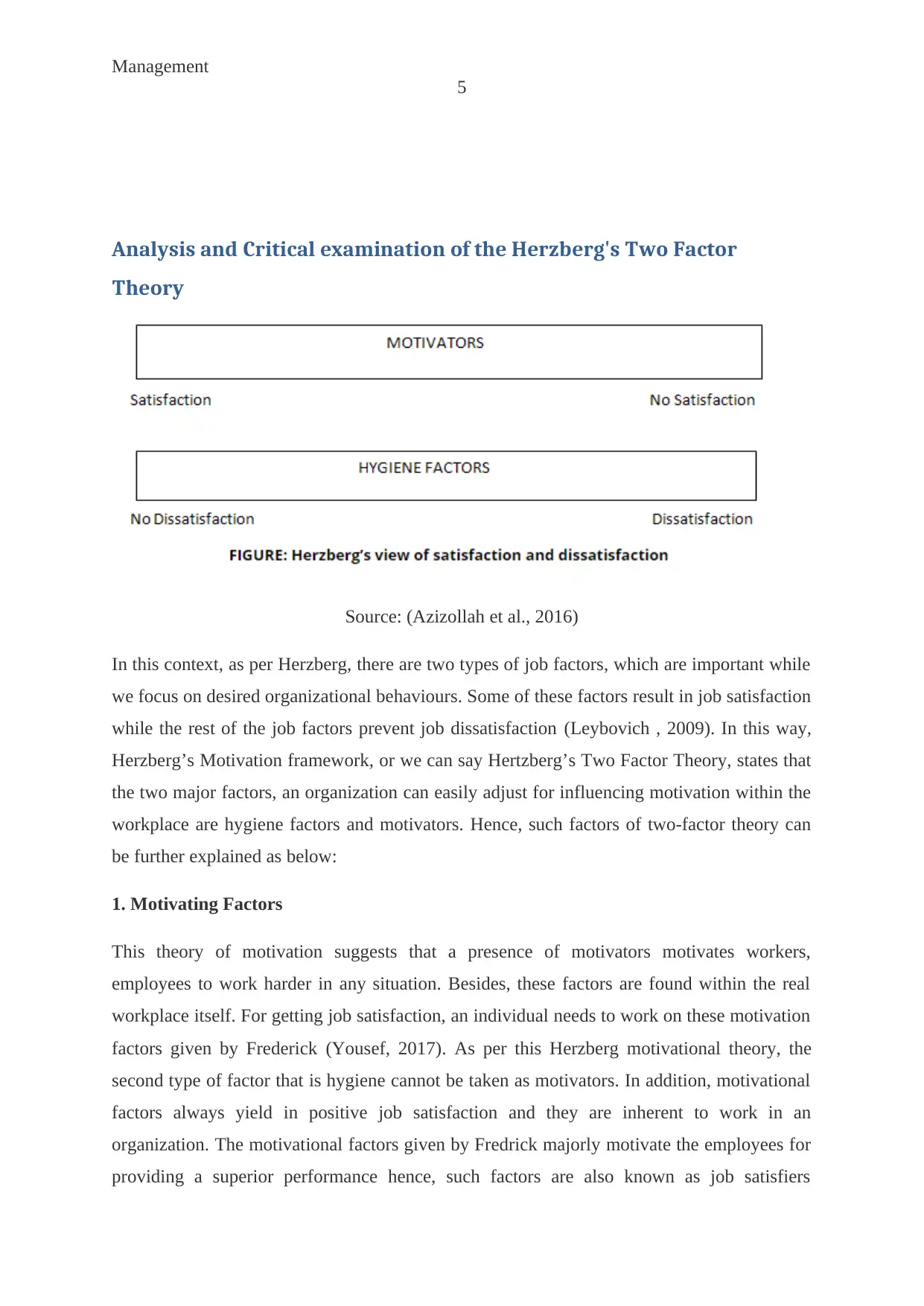
Management
5
Analysis and Critical examination of the Herzberg's Two Factor
Theory
Source: (Azizollah et al., 2016)
In this context, as per Herzberg, there are two types of job factors, which are important while
we focus on desired organizational behaviours. Some of these factors result in job satisfaction
while the rest of the job factors prevent job dissatisfaction (Leybovich , 2009). In this way,
Herzberg’s Motivation framework, or we can say Hertzberg’s Two Factor Theory, states that
the two major factors, an organization can easily adjust for influencing motivation within the
workplace are hygiene factors and motivators. Hence, such factors of two-factor theory can
be further explained as below:
1. Motivating Factors
This theory of motivation suggests that a presence of motivators motivates workers,
employees to work harder in any situation. Besides, these factors are found within the real
workplace itself. For getting job satisfaction, an individual needs to work on these motivation
factors given by Frederick (Yousef, 2017). As per this Herzberg motivational theory, the
second type of factor that is hygiene cannot be taken as motivators. In addition, motivational
factors always yield in positive job satisfaction and they are inherent to work in an
organization. The motivational factors given by Fredrick majorly motivate the employees for
providing a superior performance hence, such factors are also known as job satisfiers
5
Analysis and Critical examination of the Herzberg's Two Factor
Theory
Source: (Azizollah et al., 2016)
In this context, as per Herzberg, there are two types of job factors, which are important while
we focus on desired organizational behaviours. Some of these factors result in job satisfaction
while the rest of the job factors prevent job dissatisfaction (Leybovich , 2009). In this way,
Herzberg’s Motivation framework, or we can say Hertzberg’s Two Factor Theory, states that
the two major factors, an organization can easily adjust for influencing motivation within the
workplace are hygiene factors and motivators. Hence, such factors of two-factor theory can
be further explained as below:
1. Motivating Factors
This theory of motivation suggests that a presence of motivators motivates workers,
employees to work harder in any situation. Besides, these factors are found within the real
workplace itself. For getting job satisfaction, an individual needs to work on these motivation
factors given by Frederick (Yousef, 2017). As per this Herzberg motivational theory, the
second type of factor that is hygiene cannot be taken as motivators. In addition, motivational
factors always yield in positive job satisfaction and they are inherent to work in an
organization. The motivational factors given by Fredrick majorly motivate the employees for
providing a superior performance hence, such factors are also known as job satisfiers
⊘ This is a preview!⊘
Do you want full access?
Subscribe today to unlock all pages.

Trusted by 1+ million students worldwide
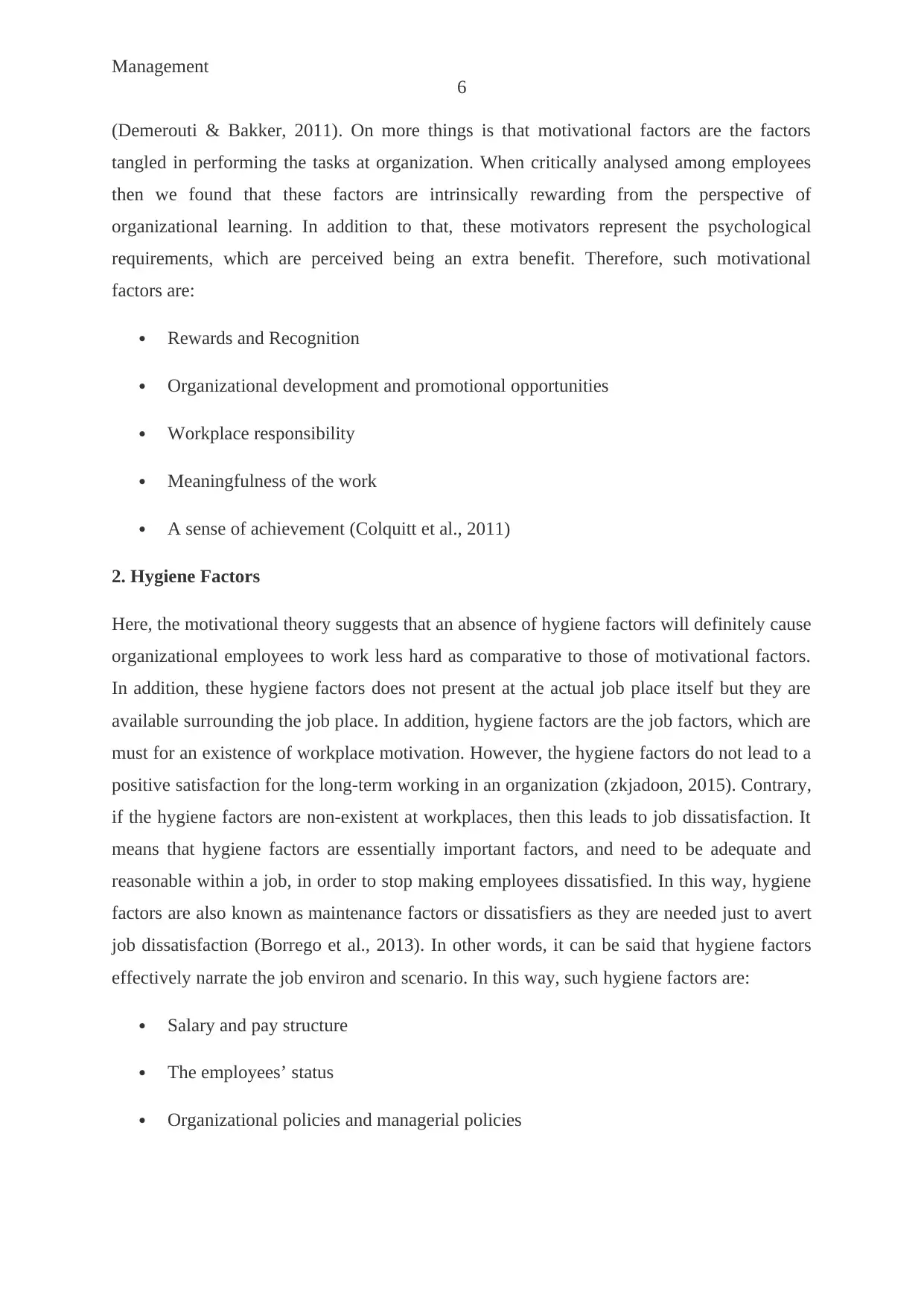
Management
6
(Demerouti & Bakker, 2011). On more things is that motivational factors are the factors
tangled in performing the tasks at organization. When critically analysed among employees
then we found that these factors are intrinsically rewarding from the perspective of
organizational learning. In addition to that, these motivators represent the psychological
requirements, which are perceived being an extra benefit. Therefore, such motivational
factors are:
Rewards and Recognition
Organizational development and promotional opportunities
Workplace responsibility
Meaningfulness of the work
A sense of achievement (Colquitt et al., 2011)
2. Hygiene Factors
Here, the motivational theory suggests that an absence of hygiene factors will definitely cause
organizational employees to work less hard as comparative to those of motivational factors.
In addition, these hygiene factors does not present at the actual job place itself but they are
available surrounding the job place. In addition, hygiene factors are the job factors, which are
must for an existence of workplace motivation. However, the hygiene factors do not lead to a
positive satisfaction for the long-term working in an organization (zkjadoon, 2015). Contrary,
if the hygiene factors are non-existent at workplaces, then this leads to job dissatisfaction. It
means that hygiene factors are essentially important factors, and need to be adequate and
reasonable within a job, in order to stop making employees dissatisfied. In this way, hygiene
factors are also known as maintenance factors or dissatisfiers as they are needed just to avert
job dissatisfaction (Borrego et al., 2013). In other words, it can be said that hygiene factors
effectively narrate the job environ and scenario. In this way, such hygiene factors are:
Salary and pay structure
The employees’ status
Organizational policies and managerial policies
6
(Demerouti & Bakker, 2011). On more things is that motivational factors are the factors
tangled in performing the tasks at organization. When critically analysed among employees
then we found that these factors are intrinsically rewarding from the perspective of
organizational learning. In addition to that, these motivators represent the psychological
requirements, which are perceived being an extra benefit. Therefore, such motivational
factors are:
Rewards and Recognition
Organizational development and promotional opportunities
Workplace responsibility
Meaningfulness of the work
A sense of achievement (Colquitt et al., 2011)
2. Hygiene Factors
Here, the motivational theory suggests that an absence of hygiene factors will definitely cause
organizational employees to work less hard as comparative to those of motivational factors.
In addition, these hygiene factors does not present at the actual job place itself but they are
available surrounding the job place. In addition, hygiene factors are the job factors, which are
must for an existence of workplace motivation. However, the hygiene factors do not lead to a
positive satisfaction for the long-term working in an organization (zkjadoon, 2015). Contrary,
if the hygiene factors are non-existent at workplaces, then this leads to job dissatisfaction. It
means that hygiene factors are essentially important factors, and need to be adequate and
reasonable within a job, in order to stop making employees dissatisfied. In this way, hygiene
factors are also known as maintenance factors or dissatisfiers as they are needed just to avert
job dissatisfaction (Borrego et al., 2013). In other words, it can be said that hygiene factors
effectively narrate the job environ and scenario. In this way, such hygiene factors are:
Salary and pay structure
The employees’ status
Organizational policies and managerial policies
Paraphrase This Document
Need a fresh take? Get an instant paraphrase of this document with our AI Paraphraser
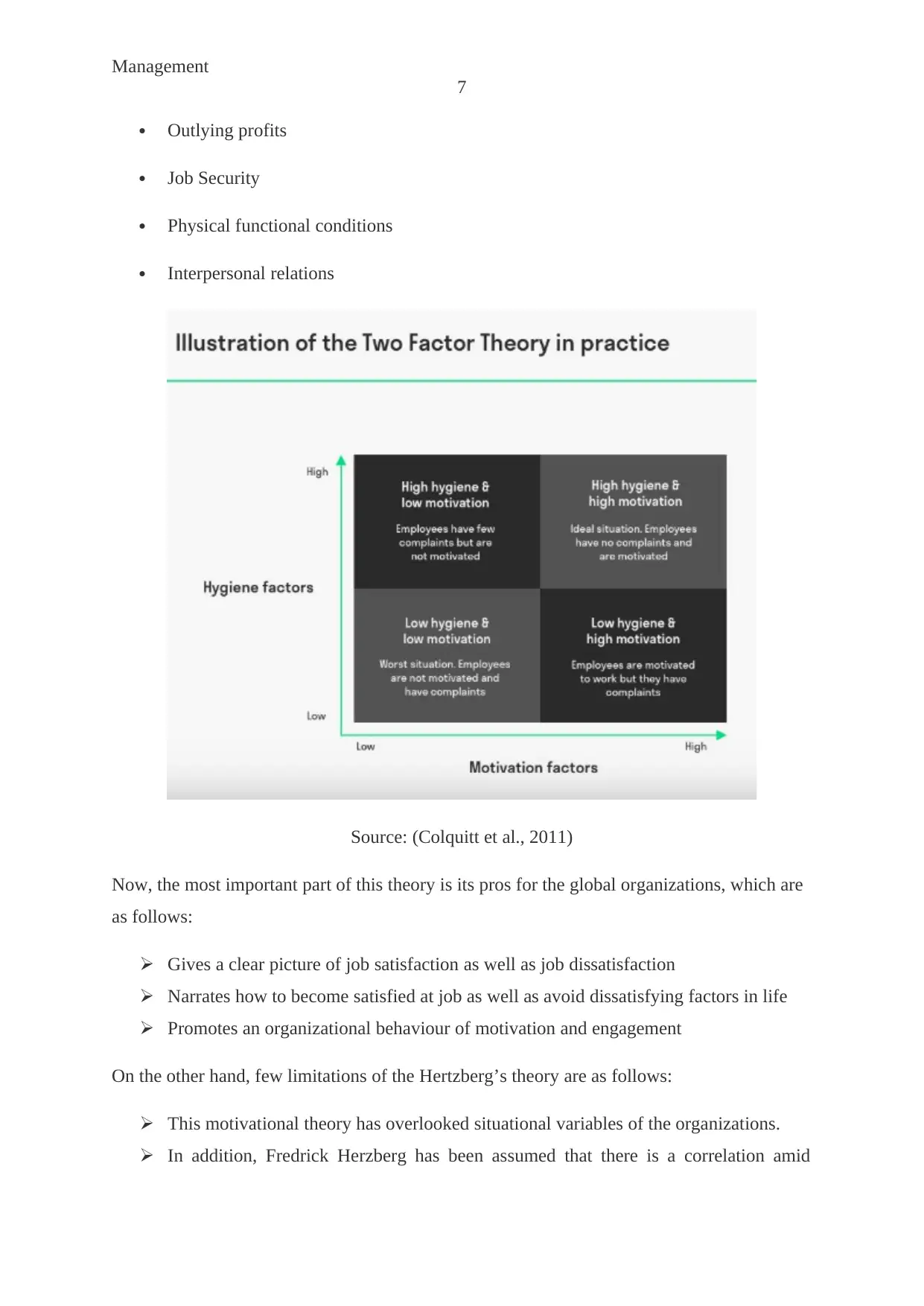
Management
7
Outlying profits
Job Security
Physical functional conditions
Interpersonal relations
Source: (Colquitt et al., 2011)
Now, the most important part of this theory is its pros for the global organizations, which are
as follows:
Gives a clear picture of job satisfaction as well as job dissatisfaction
Narrates how to become satisfied at job as well as avoid dissatisfying factors in life
Promotes an organizational behaviour of motivation and engagement
On the other hand, few limitations of the Hertzberg’s theory are as follows:
This motivational theory has overlooked situational variables of the organizations.
In addition, Fredrick Herzberg has been assumed that there is a correlation amid
7
Outlying profits
Job Security
Physical functional conditions
Interpersonal relations
Source: (Colquitt et al., 2011)
Now, the most important part of this theory is its pros for the global organizations, which are
as follows:
Gives a clear picture of job satisfaction as well as job dissatisfaction
Narrates how to become satisfied at job as well as avoid dissatisfying factors in life
Promotes an organizational behaviour of motivation and engagement
On the other hand, few limitations of the Hertzberg’s theory are as follows:
This motivational theory has overlooked situational variables of the organizations.
In addition, Fredrick Herzberg has been assumed that there is a correlation amid
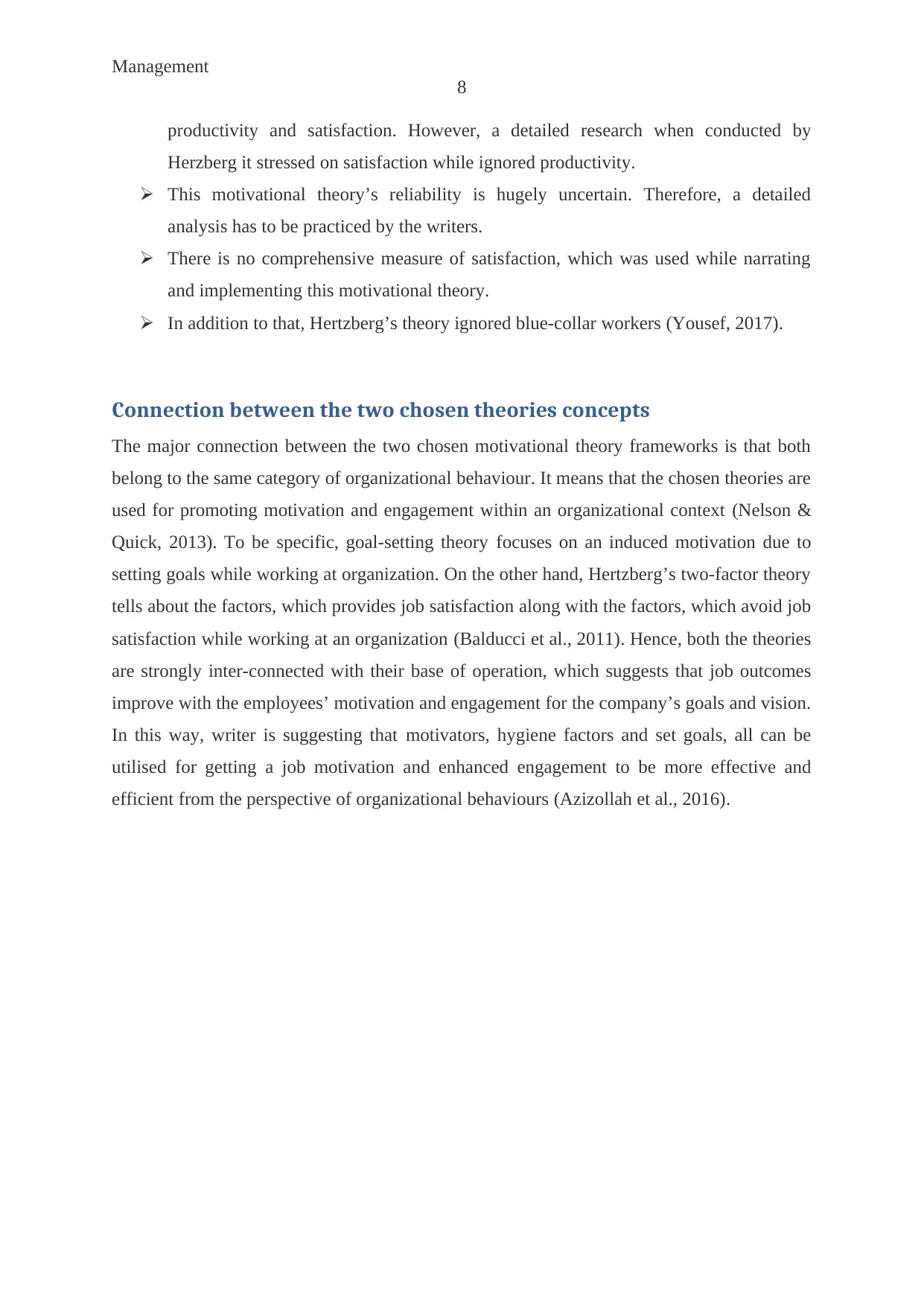
Management
8
productivity and satisfaction. However, a detailed research when conducted by
Herzberg it stressed on satisfaction while ignored productivity.
This motivational theory’s reliability is hugely uncertain. Therefore, a detailed
analysis has to be practiced by the writers.
There is no comprehensive measure of satisfaction, which was used while narrating
and implementing this motivational theory.
In addition to that, Hertzberg’s theory ignored blue-collar workers (Yousef, 2017).
Connection between the two chosen theories concepts
The major connection between the two chosen motivational theory frameworks is that both
belong to the same category of organizational behaviour. It means that the chosen theories are
used for promoting motivation and engagement within an organizational context (Nelson &
Quick, 2013). To be specific, goal-setting theory focuses on an induced motivation due to
setting goals while working at organization. On the other hand, Hertzberg’s two-factor theory
tells about the factors, which provides job satisfaction along with the factors, which avoid job
satisfaction while working at an organization (Balducci et al., 2011). Hence, both the theories
are strongly inter-connected with their base of operation, which suggests that job outcomes
improve with the employees’ motivation and engagement for the company’s goals and vision.
In this way, writer is suggesting that motivators, hygiene factors and set goals, all can be
utilised for getting a job motivation and enhanced engagement to be more effective and
efficient from the perspective of organizational behaviours (Azizollah et al., 2016).
8
productivity and satisfaction. However, a detailed research when conducted by
Herzberg it stressed on satisfaction while ignored productivity.
This motivational theory’s reliability is hugely uncertain. Therefore, a detailed
analysis has to be practiced by the writers.
There is no comprehensive measure of satisfaction, which was used while narrating
and implementing this motivational theory.
In addition to that, Hertzberg’s theory ignored blue-collar workers (Yousef, 2017).
Connection between the two chosen theories concepts
The major connection between the two chosen motivational theory frameworks is that both
belong to the same category of organizational behaviour. It means that the chosen theories are
used for promoting motivation and engagement within an organizational context (Nelson &
Quick, 2013). To be specific, goal-setting theory focuses on an induced motivation due to
setting goals while working at organization. On the other hand, Hertzberg’s two-factor theory
tells about the factors, which provides job satisfaction along with the factors, which avoid job
satisfaction while working at an organization (Balducci et al., 2011). Hence, both the theories
are strongly inter-connected with their base of operation, which suggests that job outcomes
improve with the employees’ motivation and engagement for the company’s goals and vision.
In this way, writer is suggesting that motivators, hygiene factors and set goals, all can be
utilised for getting a job motivation and enhanced engagement to be more effective and
efficient from the perspective of organizational behaviours (Azizollah et al., 2016).
⊘ This is a preview!⊘
Do you want full access?
Subscribe today to unlock all pages.

Trusted by 1+ million students worldwide
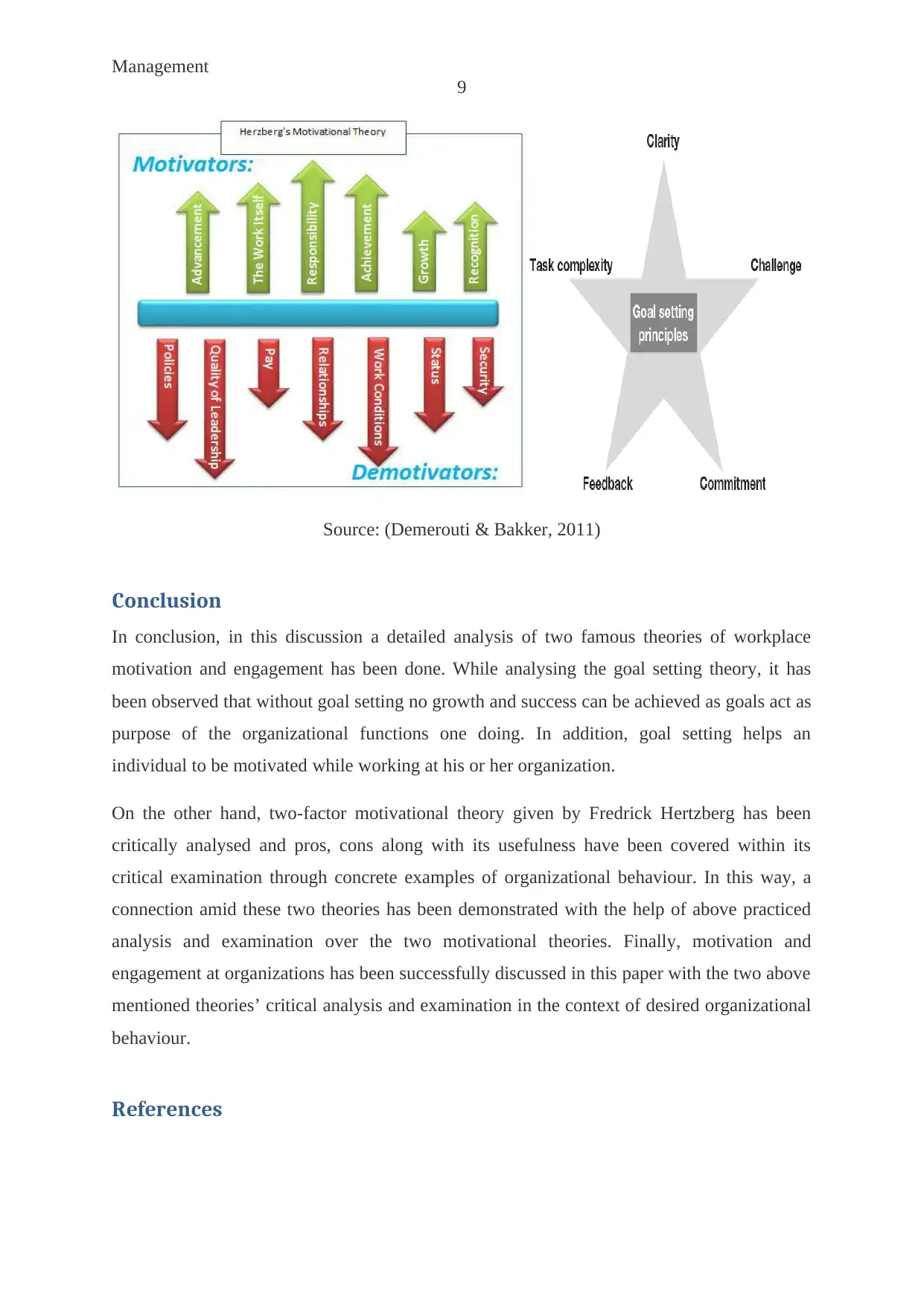
Management
9
Source: (Demerouti & Bakker, 2011)
Conclusion
In conclusion, in this discussion a detailed analysis of two famous theories of workplace
motivation and engagement has been done. While analysing the goal setting theory, it has
been observed that without goal setting no growth and success can be achieved as goals act as
purpose of the organizational functions one doing. In addition, goal setting helps an
individual to be motivated while working at his or her organization.
On the other hand, two-factor motivational theory given by Fredrick Hertzberg has been
critically analysed and pros, cons along with its usefulness have been covered within its
critical examination through concrete examples of organizational behaviour. In this way, a
connection amid these two theories has been demonstrated with the help of above practiced
analysis and examination over the two motivational theories. Finally, motivation and
engagement at organizations has been successfully discussed in this paper with the two above
mentioned theories’ critical analysis and examination in the context of desired organizational
behaviour.
References
9
Source: (Demerouti & Bakker, 2011)
Conclusion
In conclusion, in this discussion a detailed analysis of two famous theories of workplace
motivation and engagement has been done. While analysing the goal setting theory, it has
been observed that without goal setting no growth and success can be achieved as goals act as
purpose of the organizational functions one doing. In addition, goal setting helps an
individual to be motivated while working at his or her organization.
On the other hand, two-factor motivational theory given by Fredrick Hertzberg has been
critically analysed and pros, cons along with its usefulness have been covered within its
critical examination through concrete examples of organizational behaviour. In this way, a
connection amid these two theories has been demonstrated with the help of above practiced
analysis and examination over the two motivational theories. Finally, motivation and
engagement at organizations has been successfully discussed in this paper with the two above
mentioned theories’ critical analysis and examination in the context of desired organizational
behaviour.
References
Paraphrase This Document
Need a fresh take? Get an instant paraphrase of this document with our AI Paraphraser
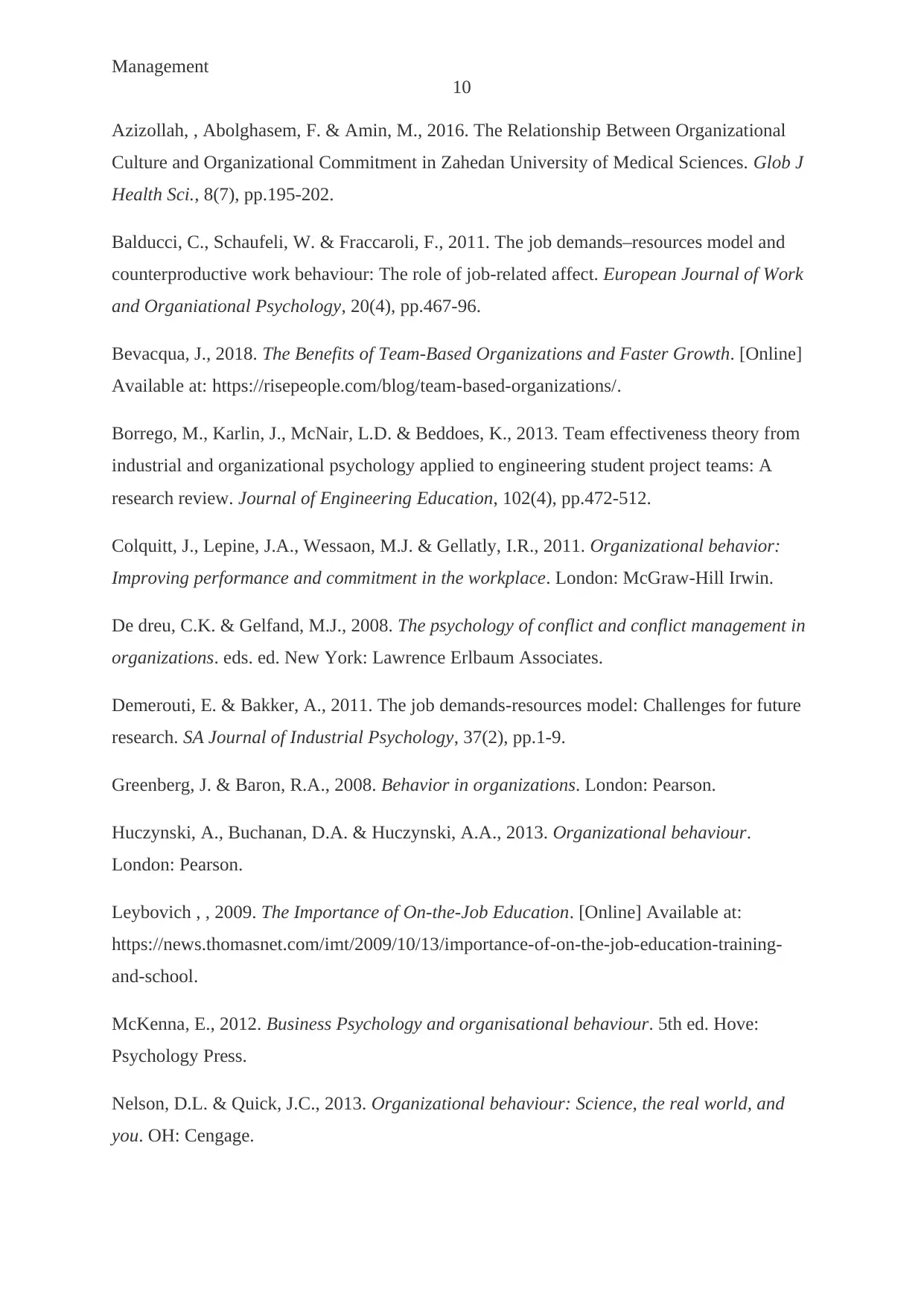
Management
10
Azizollah, , Abolghasem, F. & Amin, M., 2016. The Relationship Between Organizational
Culture and Organizational Commitment in Zahedan University of Medical Sciences. Glob J
Health Sci., 8(7), pp.195-202.
Balducci, C., Schaufeli, W. & Fraccaroli, F., 2011. The job demands–resources model and
counterproductive work behaviour: The role of job-related affect. European Journal of Work
and Organiational Psychology, 20(4), pp.467-96.
Bevacqua, J., 2018. The Benefits of Team-Based Organizations and Faster Growth. [Online]
Available at: https://risepeople.com/blog/team-based-organizations/.
Borrego, M., Karlin, J., McNair, L.D. & Beddoes, K., 2013. Team effectiveness theory from
industrial and organizational psychology applied to engineering student project teams: A
research review. Journal of Engineering Education, 102(4), pp.472-512.
Colquitt, J., Lepine, J.A., Wessaon, M.J. & Gellatly, I.R., 2011. Organizational behavior:
Improving performance and commitment in the workplace. London: McGraw-Hill Irwin.
De dreu, C.K. & Gelfand, M.J., 2008. The psychology of conflict and conflict management in
organizations. eds. ed. New York: Lawrence Erlbaum Associates.
Demerouti, E. & Bakker, A., 2011. The job demands-resources model: Challenges for future
research. SA Journal of Industrial Psychology, 37(2), pp.1-9.
Greenberg, J. & Baron, R.A., 2008. Behavior in organizations. London: Pearson.
Huczynski, A., Buchanan, D.A. & Huczynski, A.A., 2013. Organizational behaviour.
London: Pearson.
Leybovich , , 2009. The Importance of On-the-Job Education. [Online] Available at:
https://news.thomasnet.com/imt/2009/10/13/importance-of-on-the-job-education-training-
and-school.
McKenna, E., 2012. Business Psychology and organisational behaviour. 5th ed. Hove:
Psychology Press.
Nelson, D.L. & Quick, J.C., 2013. Organizational behaviour: Science, the real world, and
you. OH: Cengage.
10
Azizollah, , Abolghasem, F. & Amin, M., 2016. The Relationship Between Organizational
Culture and Organizational Commitment in Zahedan University of Medical Sciences. Glob J
Health Sci., 8(7), pp.195-202.
Balducci, C., Schaufeli, W. & Fraccaroli, F., 2011. The job demands–resources model and
counterproductive work behaviour: The role of job-related affect. European Journal of Work
and Organiational Psychology, 20(4), pp.467-96.
Bevacqua, J., 2018. The Benefits of Team-Based Organizations and Faster Growth. [Online]
Available at: https://risepeople.com/blog/team-based-organizations/.
Borrego, M., Karlin, J., McNair, L.D. & Beddoes, K., 2013. Team effectiveness theory from
industrial and organizational psychology applied to engineering student project teams: A
research review. Journal of Engineering Education, 102(4), pp.472-512.
Colquitt, J., Lepine, J.A., Wessaon, M.J. & Gellatly, I.R., 2011. Organizational behavior:
Improving performance and commitment in the workplace. London: McGraw-Hill Irwin.
De dreu, C.K. & Gelfand, M.J., 2008. The psychology of conflict and conflict management in
organizations. eds. ed. New York: Lawrence Erlbaum Associates.
Demerouti, E. & Bakker, A., 2011. The job demands-resources model: Challenges for future
research. SA Journal of Industrial Psychology, 37(2), pp.1-9.
Greenberg, J. & Baron, R.A., 2008. Behavior in organizations. London: Pearson.
Huczynski, A., Buchanan, D.A. & Huczynski, A.A., 2013. Organizational behaviour.
London: Pearson.
Leybovich , , 2009. The Importance of On-the-Job Education. [Online] Available at:
https://news.thomasnet.com/imt/2009/10/13/importance-of-on-the-job-education-training-
and-school.
McKenna, E., 2012. Business Psychology and organisational behaviour. 5th ed. Hove:
Psychology Press.
Nelson, D.L. & Quick, J.C., 2013. Organizational behaviour: Science, the real world, and
you. OH: Cengage.
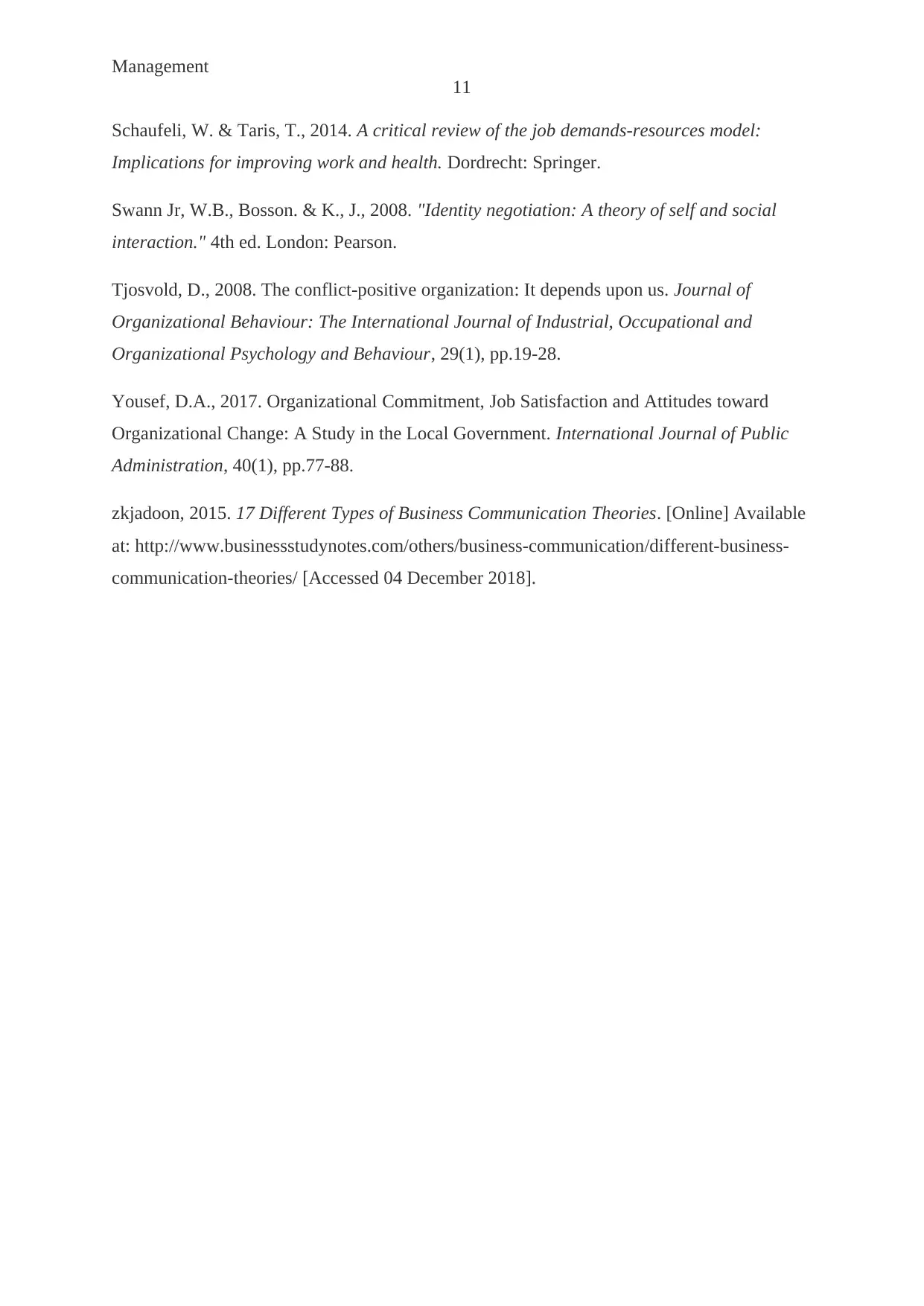
Management
11
Schaufeli, W. & Taris, T., 2014. A critical review of the job demands-resources model:
Implications for improving work and health. Dordrecht: Springer.
Swann Jr, W.B., Bosson. & K., J., 2008. "Identity negotiation: A theory of self and social
interaction." 4th ed. London: Pearson.
Tjosvold, D., 2008. The conflict‐positive organization: It depends upon us. Journal of
Organizational Behaviour: The International Journal of Industrial, Occupational and
Organizational Psychology and Behaviour, 29(1), pp.19-28.
Yousef, D.A., 2017. Organizational Commitment, Job Satisfaction and Attitudes toward
Organizational Change: A Study in the Local Government. International Journal of Public
Administration, 40(1), pp.77-88.
zkjadoon, 2015. 17 Different Types of Business Communication Theories. [Online] Available
at: http://www.businessstudynotes.com/others/business-communication/different-business-
communication-theories/ [Accessed 04 December 2018].
11
Schaufeli, W. & Taris, T., 2014. A critical review of the job demands-resources model:
Implications for improving work and health. Dordrecht: Springer.
Swann Jr, W.B., Bosson. & K., J., 2008. "Identity negotiation: A theory of self and social
interaction." 4th ed. London: Pearson.
Tjosvold, D., 2008. The conflict‐positive organization: It depends upon us. Journal of
Organizational Behaviour: The International Journal of Industrial, Occupational and
Organizational Psychology and Behaviour, 29(1), pp.19-28.
Yousef, D.A., 2017. Organizational Commitment, Job Satisfaction and Attitudes toward
Organizational Change: A Study in the Local Government. International Journal of Public
Administration, 40(1), pp.77-88.
zkjadoon, 2015. 17 Different Types of Business Communication Theories. [Online] Available
at: http://www.businessstudynotes.com/others/business-communication/different-business-
communication-theories/ [Accessed 04 December 2018].
⊘ This is a preview!⊘
Do you want full access?
Subscribe today to unlock all pages.

Trusted by 1+ million students worldwide
1 out of 12
Related Documents
Your All-in-One AI-Powered Toolkit for Academic Success.
+13062052269
info@desklib.com
Available 24*7 on WhatsApp / Email
![[object Object]](/_next/static/media/star-bottom.7253800d.svg)
Unlock your academic potential
Copyright © 2020–2025 A2Z Services. All Rights Reserved. Developed and managed by ZUCOL.





